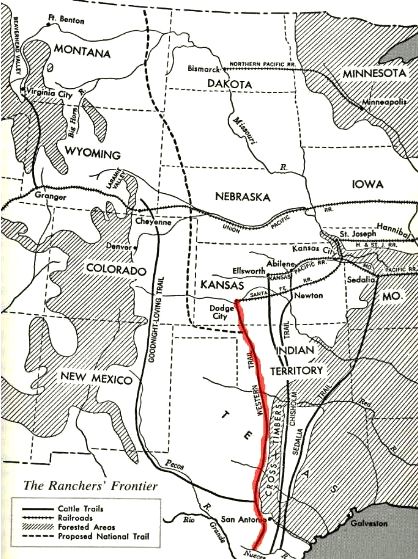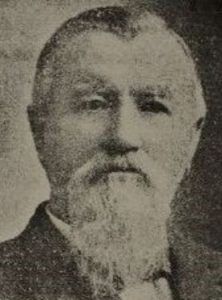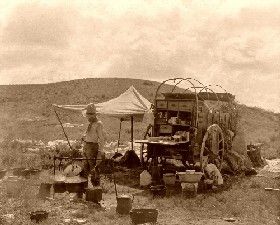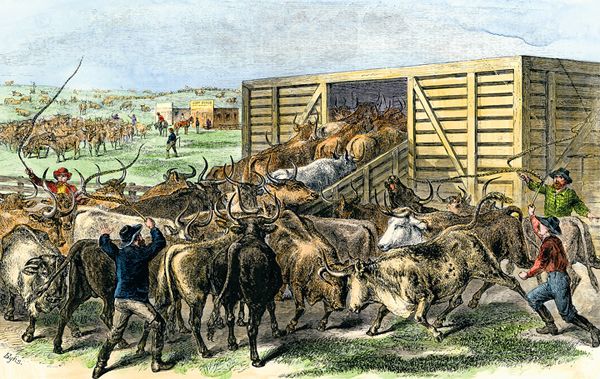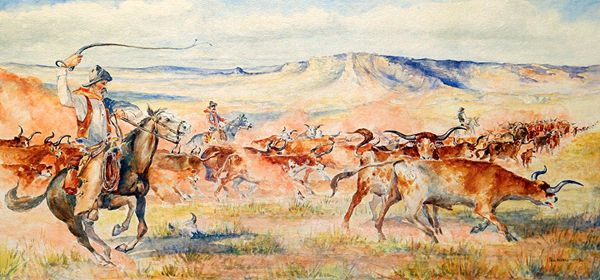“At that time (1873) one thousand pound beeves sold in San Antonio for $8 per head, sold in Wichita, Kansas for $23.80 per head.”
— C.W. Ackerman, San Antonio Cowboy
The Great Western Cattle Trail, also known as the Western Trail, Fort Griffin Trail, Dodge City Trail, Northern Trail, and Texas Trail, wasn’t as well known as some of the other cattle trails, but it was longer and carried cattle for two years longer than did the Chisholm Trail.
Following the Civil War, the construction of the Transcontinental Railroad opened the West at the same time that Texas cattlemen were desperately seeking opportunities to sell their cattle. Early trails included the Shawnee Trail and the Chisholm Trail, which would go out of use as the railroad moved westward.
In 1874, John T. Lytle, who was transporting 3,500 longhorn cattle from the grazing ranges of Texas to Fort Robinson, Nebraska, blazed the trail. The road began in the Kerrville, Texas, hill country and ran west of and roughly parallel to the Chisholm Trail into Kansas.
In 1875, when the U.S. Army successfully concluded the Red River War, which drove the Comanche and Kiowa onto reservations, Lytle’s Trail became the most popular path to the railheads in Kansas and Nebraska. By 1879, it would become one of U.S. history’s most traveled and famous cattle trails.
Moving 10-12 miles daily, a typical cattle drive would take about two months to travel from South Texas to Kansas. Though the cattle could be driven as far as 25 miles in a single day, they would lose too much weight and be hard to sell when they reached the trail’s end. If the cattle were skillfully managed, they could gain weight along the trail.
Drovers learned the best size herd to move over long distances was 2,500-3,000 head, which moved slowly to avoid a stampede. Usually, the cattle were taken shorter distances each day and allowed to rest and graze at midday and night.
A crew of at least ten cowboys was needed to herd the cattle, with three horses per cowboy. These men worked in shifts to watch the cattle 24 hours a day, herding them in the daytime and watching them at night to prevent stampedes and theft. The crew also included a trail boss, a cook, who drove a chuck wagon, and a horse wrangler to take charge of the spare horses. The wrangler was often a very young cowboy or one of lower social status. The cook was an exceptionally well-respected member of the crew, as not only was he in charge of the food, but he also was in charge of medical supplies and had a working knowledge of practical medicine. The two-month trip would cost about $1000 in wages and provisions.
At the trail’s end, cattle sold for $20.00 to $35.00 per head. At that time, the cowboys were paid and turned loose. After months of monotonous work, dull food, and abstinence of all kinds, they got shaved and shorn, bought new clothes and gear, and often let off steam by drinking and gambling. Cowtowns were often decadent and violent at the end of the trail, boasting numerous saloons, gambling halls, and brothels. To curb this rowdiness, effective lawmen were needed. Some of the more famous were James Butler Hickok, Wyatt Earp, and Bat Masterson. After the cowboys had rested for several days, they usually returned home with their wagons and horses.
Most of the cattle along the trail were shipped out of Dodge City, Kansas, along the railroad. However, as cattlemen learned of the great open ranges to the north, many began trailing their herds further into Nebraska, Wyoming, Montana, the Dakotas, and even as far north as Canada.
Despite its popularity, traffic along the trail began to decline in 1885 due to the spreading use of barbed wire fences, the introduction of beefier cattle breeds, and the settlement of the frontier. But the most significant contributor to the trail’s demise was quarantines of Texas cattle due to the “Texas Fever” – a disease spread by a parasitic tick. Carried northward by longhorns, the disease decimated northern herds, causing many northern states and territories to ban Texas cattle. As a result, Texas congressman James Francis Miller, Art Lytle’s brother-in-law, introduced legislation that would have plotted a National Trail north of Texas under federal supervision, but the proposal did not pass.
The last reported drive on the Great Western Trail was made in 1893 by John Rufus Blocker, who drove his herd from West Texas to Deadwood, South Dakota. By then, as many as six million cattle and one million horses had been driven to northern pastures and markets.
Along this trek, Dodge City, Kansas, boasted of being the “cowboy capital of the world.” Communities in other states served the trade, including Ogallala, Nebraska; Cheyenne, Wyoming; Miles City, Montana; and Medora, North Dakota. Amarillo, Fort Worth, Buffalo Gap, Abilene, Doan’s Crossing, and Seymour, all in Texas, were important stops along the trail.
© Kathy Alexander/Legends of America, updated September 2023.
Also see:
The Cattle Trails (historic text)
Tales & Trails of the American Frontier
The Cattle Kings (historic text)
Sources:
Oklahoma Historical Society
The Great Western Trail
Wikipedia

